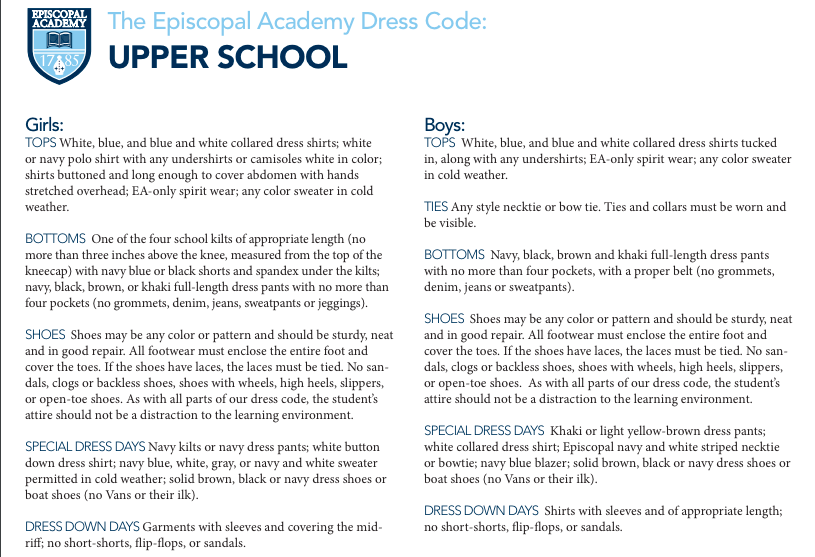STAFF EDITORIAL

Photo courtesy of the Upper School Student Handbook
According to the Upper School Student Handbook, “The dress code is an important part of Episcopal Academy’s life. The dress code contributes to a sense of campus decorum and simplicity, as well as reduces superficial comparisons between people while emphasizing the common experience that we share as members of this school community.” The document continues, “Abiding by the dress code guidelines conveys a respect for self and others that underlies the Episcopal philosophy. Students are required to live within both the spirit and letter of the dress code.”
Overall, we think the dress code serves a vital purpose at EA. First, it creates a sense of unity and levels the playing field among students by making it difficult for students to be singled out for their fashion choices. The very nature of having a uniform instills values of discipline and professionalism, but we also like how there is still enough leeway for students to express individuality through their clothing. Reagan Snyder ‘20 states, “I think EA is on the more lenient side with regards to a uniform. I think freedom with footwear, jackets, etc have opened a door for students to express themselves and therefore be more comfortable in the community.” We appreciate having the option to choose how much time and thought we put into dressing ourselves—students can choose whether they want to stick with the standard uniform or coordinate their outfit a bit more.
At the same time, however, we feel that the school uniform is not without criticism. The girls’ uniforms, for instance, allow for far more leeway and room for individuality to students. Girls have the option of skirts or pants, and the ability to choose whether or not to wear leggings under skirts gives female students an option to regulate their legwear depending on the temperature. Boys, however, are not given any option as they must wear full-length pants regardless of the season. In addition, we feel that male students are subject to additional limitations that make their uniform significantly more uncomfortable than the girls’. They must tuck in their shirts, wear ties at all times, and are forced to wear dress shirts while the girls may choose between dress shirts and polos. Snyder proposes a potential solution to this discrepancy, “I think if I were to address this [problem], I would allow boys to wear a polo or golf shirt—if it’s EA—on Fridays. I know other schools that have taken this approach and it helped confront student feelings of frustration about the shirt-tie requirements.”
Though we feel that this gender discrepancy needs to be addressed, we believe that the dress code is overall quite lenient and is a generally positive addition to the student experience. However, students at EA seem to take the leniency of our uniform for granted. When it comes to living “within the spirit of the dress code,” as the Upper School Student Handbook describes, we feel that many students feel the need to disobey the dress code over extremely minor issues, like the difference between sweatpants and leggings or between EA sweatshirts and non-EA sweatshirts. Sejin Park ‘20 explains, “I think the uniform has gotten a lot more unofficially lax. A lot of people just wear non-EA hoodies whenever they feel like it.” Schools like Malvern Prep and Haverford do not allow students to wear sweatshirts of any kind during normal dress days, while Agnes Irwin limits girls’ dress code to sweaters that are either navy or white on all days except Friday. Page Gerardi, a senior at Notre Dame Academy de Namur, says, “The biggest reason that girls [at my school] follow the uniform is because we have an ‘honor code’ system that enforces rules without any sort of punishment on the line (we don’t have detentions or demerits). Since we are given the privilege of having the honor code, everyone respects it knowing that it could be taken away if abused.”
We want to urge our fellow students to appreciate our school’s dress code rather than actively work against it. Despite its pitfalls, we support the dress code at EA. We think it contributes to a diligent working environment, a sense of unity, and makes getting dressed in the morning more simple. Case Hummer ‘20 notes, “The uniform at EA is part of the identity of the school and is somewhat of a tradition at the school. Like other traditions such as Haverford/AIS day it is one of the aspects that makes EA so unique.”